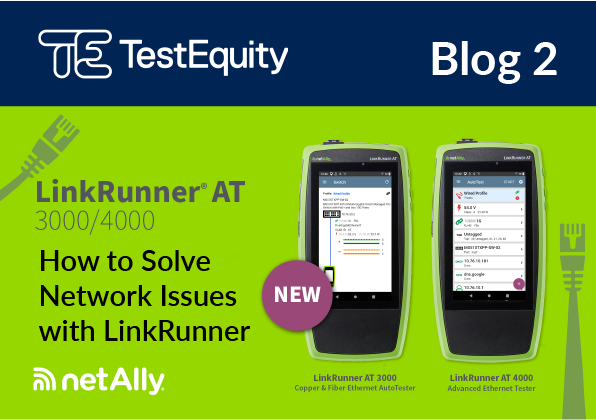In the world of IT networking, having the right tool can mean the difference between hours of troubleshooting and a quick, efficient resolution. The LinkRunner AT Ethernet Testers—models AT 3000 and AT 4000—are designed to empower network technicians, engineers, and IT professionals to swiftly diagnose and resolve network issues on-site. Whether you’re facing a problem with power over Ethernet (PoE) or hunting down an elusive connection issue, the LinkRunner AT series offers intuitive, field-friendly solutions to get you back on track.
In this blog, we’ll explore the real-world challenges that network professionals encounter and how the LinkRunner AT testers can address these issues quickly and effectively.
1. PoE Testing and Troubleshooting: Ensuring Proper Power for Devices
Today’s networks rely heavily on Power over Ethernet (PoE) for devices like IP cameras, phones, and wireless access points. However, determining whether a device is receiving the correct amount of power or diagnosing why a PoE-enabled device isn’t functioning can be tricky. The LinkRunner AT 3000 and AT 4000 testers make PoE troubleshooting a breeze with their ability to:
- Measure PoE voltage and power delivered to a connected device.
- Simulate the connection of a powered device (PD) to test actual power delivery.
- Display PoE class and power level—allowing you to verify that the power supplied matches device requirements.
This tool gives you a clear readout in seconds, allowing you to isolate power issues before moving on to more complex diagnostics.
Use Case: When an IP phone fails to power up, the LinkRunner can quickly verify whether the switch is providing sufficient power, cutting troubleshooting time significantly.
2. Network Connectivity: Identifying and Resolving Link Problems
If a workstation or device isn’t connecting properly, LinkRunner’s AutoTest feature is a must-have. In just a few seconds, it performs a complete analysis of cable integrity, link speed, and network connectivity to pinpoint the problem. For example, LinkRunner can help:
- Identify if cabling is the source of the issue.
- Test whether the Ethernet switch port is properly configured and active.
- Determine the link speed (10/100/1000 Mbps) and whether it matches the device’s capabilities.
Use Case: A user complains that their workstation can’t connect to the network. Rather than guessing whether it’s a cabling issue, a switch problem, or something else, you can use the AutoTest function to quickly diagnose and solve the issue on-site.
3. Network Discovery: Mapping the Network in Seconds
Understanding the structure of your network can be crucial when you’re asked to troubleshoot or upgrade existing infrastructure. The LinkRunner AT’s network discovery feature allows you to instantly map out connected devices, including switches, servers, and access points. You’ll see:
- Device names, IP addresses, and VLAN IDs.
- Details about switches and connected devices, helping you locate and verify network elements quickly.
- Information about connected network services such as DHCP and DNS.
Use Case: You’re on a new site and tasked with resolving network issues, but you don’t have a full understanding of the network layout. Using the LinkRunner’s discovery tool, you can create a map of connected devices in minutes, allowing you to pinpoint where and how a problem device is connected.
4. Cable Testing and Wire Mapping: Tracking Down Physical Issues
Cable-related issues are one of the most common causes of connectivity problems, whether it’s a damaged wire, miswired cable, or an incorrectly terminated connector. With the LinkRunner AT, you can:
- Perform a cable test to verify wiring, detect opens, shorts, or split pairs.
- Identify the exact distance to a fault using Time Domain Reflectometry (TDR) technology, allowing for precise physical troubleshooting.
- Test for cable length and termination points to ensure proper installation.
Use Case: A network technician finds that a device isn’t connecting due to a cabling issue. Using the LinkRunner, they can isolate the location of the fault and determine if the issue is with the cable itself or the termination at the switch, reducing unnecessary guesswork.
5. Streamlining Your Workflow with Link-Live Integration
The LinkRunner AT 4000 offers an even more advanced solution for technicians working across multiple job sites by integrating with Link-Live, a cloud-based reporting system. By automatically uploading test results, Link-Live enables:
- Instant documentation of tests and results for each job site.
- Collaboration with other team members through shared reports.
- Centralised record-keeping, so you can quickly reference past tests when revisiting a site.
Use Case: You’re responsible for multiple networks across various sites. With Link-Live, all your tests and results are automatically stored and accessible, ensuring you have consistent records without manual logging.
Conclusion: Empowering Network Technicians with Fast, Effective Tools
The LinkRunner AT Ethernet Testers are designed for one purpose: to help network professionals solve issues faster and more efficiently. By offering a comprehensive suite of tests and real-time data on PoE delivery, cabling, and network devices, these testers allow you to diagnose problems quickly, saving valuable time and preventing downtime. Whether you’re dealing with power issues, connectivity problems, or complex network configurations, the LinkRunner AT 3000 and AT 4000 provide the practical tools you need to get the job done right.
By using these tools in the field, you’ll be able to tackle a wide range of networking challenges with confidence—knowing that the LinkRunner AT series has your back.
The difference between LinkRunner AT 3000 & AT 4000:
WANT TO BUY A LINKRUNNER AT 3000 OR AT 4000? CLICK ON THE LINK BELOW:
Testimonials
In terms of network validation, and copper and fiber Ethernet configuration, I can’t imagine life without LinkRunner devices. The minute I got the 10G, everybody was fighting over it. They had never used such a device before and it was just breath-taking for them to very quickly see the validation you can gain from these devices.
Dave Bennett – Director of Technology at a educational organisation with 201-500 employees – NetAlly Customer – From NetAlly*







